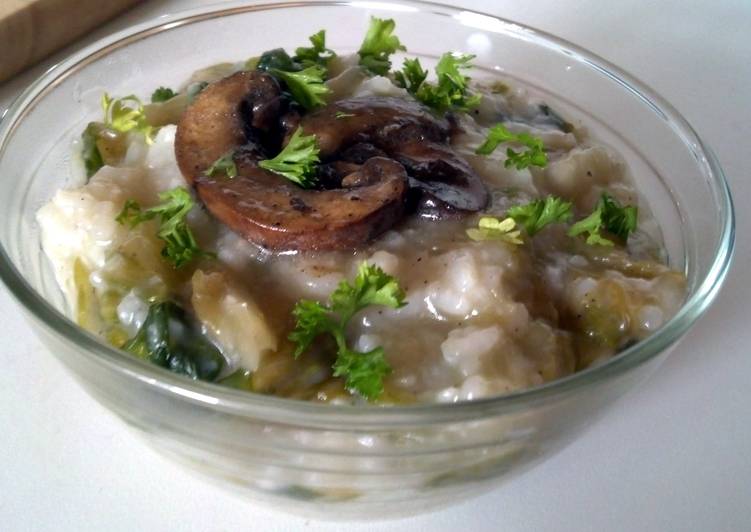Chinese Congee( Zhou). In Taiwan, congee is made from rice, water, and other ingredients, and is known as xifan(稀飯)or zhou(粥)in Written Chinese, which may also be used by Mainland Chinese people. 粥 in particular may be used by other Sinitic languages, like Cantonese, to refer to the same kind of food. Chinese congees (Chinese: 粥; pinyin: zhōu; Cantonese Yale: jūk) vary considerably by region. Congee can also be made from brown rice, although this is less common and takes longer to cook.
 The origin of the congee remains a mystery to this day.
Indeed, historians do not agree on the date or the origin of traditional Chinese porridge.
Congee is a classic Chinese porridge made from rice, usually served for breakfast or at dim sum.
You can have Chinese Congee( Zhou) using 7 ingredients and 5 steps. Here is how you achieve it.
The origin of the congee remains a mystery to this day.
Indeed, historians do not agree on the date or the origin of traditional Chinese porridge.
Congee is a classic Chinese porridge made from rice, usually served for breakfast or at dim sum.
You can have Chinese Congee( Zhou) using 7 ingredients and 5 steps. Here is how you achieve it.
Ingredients of Chinese Congee( Zhou)
- Prepare 1/2 cup of rice(I used short grain).
- It's 1 cup of water.
- You need 1 cup of Chicken Stock( you can use beef if you like).
- You need of Add Ins(Optional, but recommended).
- You need 1 of Meat of your choice ; shredded or cut up into pieces.
- You need 1 of Vegetables: I recommend using either cabbage or mushrooms.( I used cabbage for this recipe).
- Prepare 1 of Thousand year old eggs( pi dan) (This is what you would find in most congee prepared in takeout/resturant places).
It can have sweet or savory toppings--the classic has pork, scallions, ginger, and thousand year old egg. Lately, I've been rethinking a common Chinese staple: porridge, aka "congee," "粥 (zhou)," or "稀饭 (xi-fan)." In China, Northerners like it plain (白粥), but Southerners like plenty of additional flavor. As a simple rice porridge, congee is an excellent way to take advantage of the grain's health benefits. Congee is a good source of carbohydrates and protein with nearly no fat or sugar, and the high water content is hydrating Congee has been a staple in Chinese diets for centuries, and it has played an integral role in traditional Chinese medicine.
Chinese Congee( Zhou) instructions
- I recommend using a Dutch oven . If you don't that is fine too. Place the rice,.water, and stock into a pot. Stir and bring to a boil.(Make sure to not fully cover the pot because because the it can bubble over easily and make a big mess! ).
- While it is being brought to a boil, you can cook and prepare any add ins if you are using any. Set it aside. We will add this later in the cooking process ..
- After the rice and liquid mixture has been brought to a boil, add 1/2 cup of water and them bring it to a boil again. Remember to stir often. Then after the second boil, add 1/2 of a cup of stock. Bring it to a boil again. Keep repeating and alternating between water and stock until you reach your desired consistency. You can add more stock to water. This will result in a creamier and thicker congee. More water will result in more of a runny consistency, and not as much flavor. This congee is different from ones prepared outside because the ones outside are made with all water. In my opinion ,this is much more flavorful because of the stock!.
- After it has reached your desired consistency, add any of the add ins. Season to taste..
- Serve and enjoy!.
A savory rice porridge that can be eaten plain, dressed up with condiments, or made into a more substantial meal with other mix-ins. It's a typical Chinese breakfast food that can also be eaten at other times of the day and especially if one is feeling ill. Ba Bao Zhou is also known as eight treasure congee or eight treasure porridge. This post is super exciting for me because it marks the first recipe in my Authentic Chinese Series (see also Authentic Chinese: Vegan Chinese Snacks ) where I hope to share with you some authentic Chinese dishes that I learn to prepare while living in China. Congee is also known as rice porridge, jook, zhou, xi fan, or even gruel, but I'm going to stick with calling it congee because that's what I called it growing up.